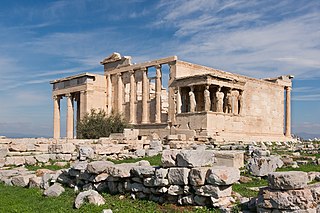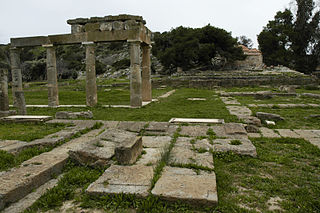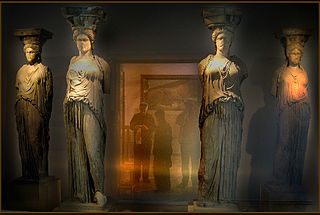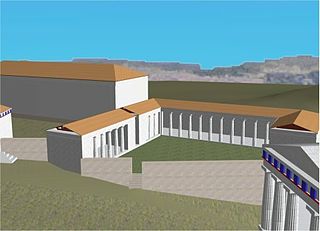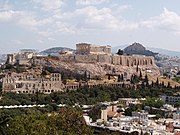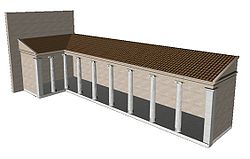
The Pandroseion (pronounced: panδrosion, Greek: Πανδρόσειον) was a sanctuary dedicated to Pandrosus, one of the daughters of Cecrops I, the first king of Attica Greece, located on the Acropolis of Athens. It occupied the space adjacent to the Erechtheum and the old Temple of Athena Polias.
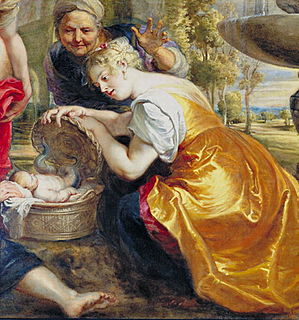
Pandrosos or Pandrosus was known in Greek myth as one of the three daughters of Kekrops, the first king of Athens, along with her sisters Aglauros and Herse. The three of them together are often referred to collectively as the Kekropidai after their father.
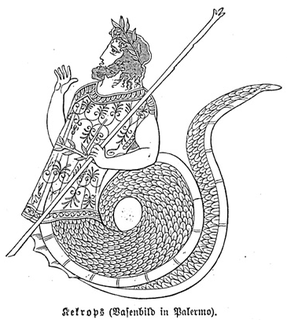
Cecrops was a mythical king of Attica which derived from him its name Cecropia, having previously borne the name of Acte or Actice. He was the founder and the first king of Athens itself though preceded in the region by the earth-born king Actaeus of Attica. Cecrops was a culture hero, teaching the Athenians marriage, reading and writing, and ceremonial burial.

Ancient Greece was a civilization belonging to a period of Greek history from the Greek Dark Ages of the 12th–9th centuries BC to the end of antiquity. Immediately following this period was the beginning of the Early Middle Ages and the Byzantine era. Roughly three centuries after the Late Bronze Age collapse of Mycenaean Greece, Greek urban poleis began to form in the 8th century BC, ushering in the Archaic period and colonization of the Mediterranean Basin. This was followed by the period of Classical Greece, an era that began with the Greco-Persian Wars, lasting from the 5th to 4th centuries BC. Due to the conquests by Alexander the Great of Macedon, Hellenistic civilization flourished from Central Asia to the western end of the Mediterranean Sea. The Hellenistic period came to an end with the conquests and annexations of the eastern Mediterranean world by the Roman Republic, which established the Roman province of Macedonia in Roman Greece, and later the province of Achaea during the Roman Empire.
The sanctuary was a walled trapezoidal courtyard containing the altar of Zeus Herkeios (protector of the hearth, of the courtyard) under the sacred Olive Tree planted by Athena. At the west was an entrance stoa from the propylea. In the northeast corner was an elaborate entrance into the north porch and the entire Etrechtheion complex. At the east, there was also a small opening through which the Thalassa of Poseidon could be viewed. The south-east corner gave access to what some thought was the tomb of Cecrops. The sanctuary also contained the sacred olive tree which was presented by Athena to the city of Athens, after her victory over Poseidon in the contest for the land of Attica.

Zeus is the sky and thunder god in ancient Greek religion, who rules as king of the gods of Mount Olympus. His name is cognate with the first element of his Roman equivalent Jupiter. His mythologies and powers are similar, though not identical, to those of Indo-European deities such as Jupiter, Perkūnas, Perun, Indra and Thor.

Athena or Athene, often given the epithet Pallas, is an ancient Greek goddess associated with wisdom, handicraft, and warfare, who was later syncretized with the Roman goddess Minerva. Athena was regarded as the patron and protectress of various cities across Greece, particularly the city of Athens, from which she most likely received her name. She is usually shown in art wearing a helmet and holding a spear. Her major symbols include owls, olive trees, snakes, and the Gorgoneion.

Poseidon was one of the Twelve Olympians in ancient Greek religion and myth. He was god of the Sea and other waters; of earthquakes; and of horses. In pre-Olympian Bronze Age Greece, he was venerated as a chief deity at Pylos and Thebes. His Roman equivalent is Neptune.

